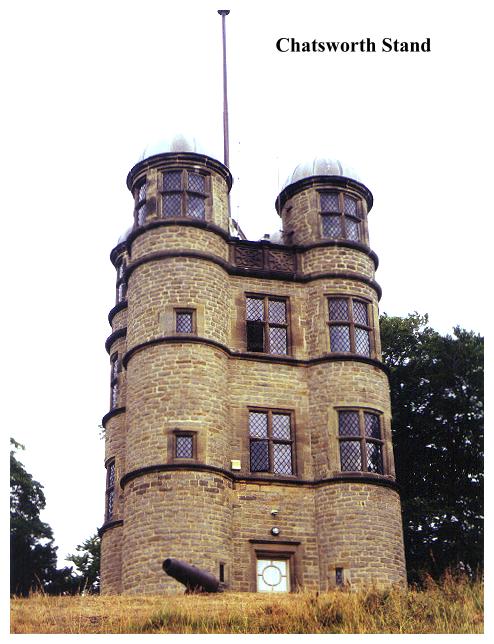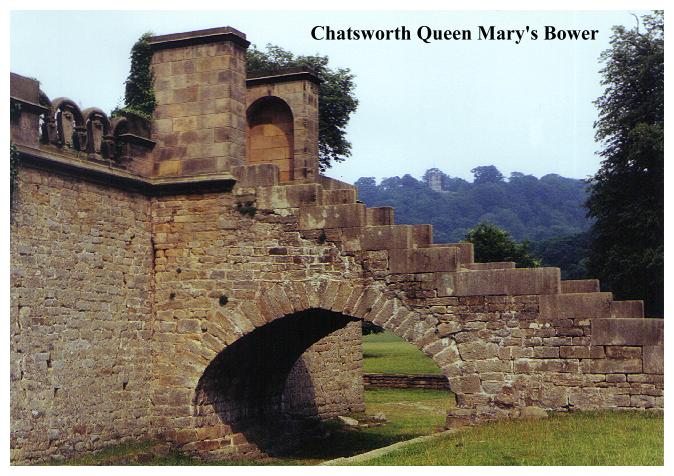3. THE CHATSWORTH PARK FOLLIES
Woods, waterfalls, lakes, moors and parkland characterise this enjoyable ramble around Chatsworth's outer fringes.
Getting There: Chatsworth is 8 miles north of Matlock off the B6012. It is 16 miles from the M1 (Junction 29)
Distance: Three miles. (easy!)
Map ref: SK 263 704 (or if starting from Robin Hood:- SK 281 722)
Rating: Walk *** Follies and General Interest **
Additional Information:
This walk starts from the main carpark at Chatsworth, where there is a parking fee. For anyone uninclined to fork out, the walk could be undertaken from Baslow, Edensor or Robin Hood, but any of these options will make it longer. Also parking at Baslow is on a 'pay & display' basis. At least at Chatsworth you can stay all day for your pound and enjoy pleasant surroundings to boot!
Chatsworth House & Gardens are open to the public from to 11am to 4.30pm daily. There are various attractions and various admission charges, subject to revision. For information of current charges and attractions contact. Chatsworth, Bakewell, Derbyshire DE4 1PP Tel: Baslow (0246) 582204. There is no admission charge for the Stand Wood nature trails, which for the most part are on concessionary footpaths. The stable block adjacent to the carpark contains toilets, a restaurant and a shop.

Chatsworth, that great seat of the Dukes of Devonshire is in summer a tourist mecca. Even on a dull weekend, there is no escaping the crowds that mill around the stable block, picnic in the grounds and explore the magnificent house and gardens. At the back of it all is the farm, open to the public and a delight for the kids, but for many people it marks the limit of their exploration, for beyond, on the nature trails of the Stand Wood we are in the domain of the walker.
When ambling around the magnificent fountains and lawns of Chatsworth we are standing at the heart of a set piece- an architectural drama, yet up in the hidden recesses of Stand Wood, tucked away behind the scenes, hidden backstage, is all the machinery and grand design that makes Chatsworth's weekly hydraulic performances possible. For the steep escarpment that dominates Chatsworth's eastern side is home to a complex system of artificial lakes, pipes and watercourses, unnoticed by those who enjoy the fountains below.
Prior to the 18th century area east of Chatsworth was a bare, bleak and rocky hillside crossed by what was then the main packhorse route from Bakewell to Chesterfield. The present landscape, with its network of artificial watercourses, tree plantations and pleasant walkways were all part of a grand design, the first stage of which was begun in 1760 when the 4th Duke of Devonshire employed Lancelot (Capability) Brown to redesign his park. Brown established much of the present aspect of the Park, and at various times between the 1750's and the mid 19th century vast numbers of beech, spanish chestnuts and sycamore trees were planted in Stand Wood. In victorian times this stock was supplemented by large numbers of conifers and rhodedendrons. The watercourses and walks in Stand Wood were the work of Joseph Paxton, who worked for the sixth duke between 1835 and 1845. At this time romantic landscapes were all the rage and the steep hillside with its boulders and fine views presented an excellent opportunity to create a natural extension to the grounds It also provided an eminently suitable source of water for the fountains in the gardens below, permitting, as G.F. Chadwick put it, "the storage of water at a considerable head above the point of display." (G.F. Chadwick - Work of Joseph Paxton.") The hillside was first surveyed in December 1843, and not long after a two-and-a half mile long conduit, (The Emperor Stream) was dug across the moor far above Chatsworth to a reservoir (The Emperor Lake), slightly to the west of the existing Swiss Lake, and standing 350 feet above Chatsworth House.We will encounter parts of this system in the course of our perambulation.

From the carpark follow the track up to the farmyard, near which there is a map showing the nature trails. Do not enter the farmyard (admission charge) but instead bear right up the road into Stand Wood, soon following a route to a junction of paths at The Dell. Continue straight on, to the Aqueduct.

The Aqueduct dates from 1839, and is a key part of Joseph Paxton's grand design for providing the water supply for Chatsworths' pools and fountains. The broken aqueduct was the idea of Paxton's patron, the 6th Duke of Devonshire, who was inspired by a similar but much bigger structure he encountered in the folly garden of Schloss Wilhelmshohe near Kassel. Ruined aqueducts were very much in vogue in Germany at that time, and the Chatsworth Folly looks very much like one depicted in Grohmann's Ideen-magazin of 1796-1810. The fall on the broken end of the aqueduct is 80 feet, and in winter the icicles give it a beautiful appearance. It was restored in 1970.
Passing under the Aqueduct, the path now starts to zigzag up the slope on the right bank of the stream, there being a series of steps and stone kerbs. First the top of the Aqueduct appears, then the bottom of the waterfalls, before a final flight of steps leads to the Sowter Stone, from which there is an excellent view down into the park.
Beyond the Sowter Stone bear right along a well defined farm track which leads along the top of Stand Wood for about a quarter of a mile. Just before reaching a metalled lane, a grassy track leads off left ascending through conifers, to join a farm road, by a mauve arrow sign. Turn left, and follow the track up the hillside, running through a corridor of woodland bounded by open country. The road winds round to the left to a junction of lanes. Ignore the track leading off right to the Swiss Cottage , and continue straight on. Soon the Swiss Lake comes into view on your right, with the Cottage (built in 1839) on its far bank.The 9 acre Swiss Lake and the nearby Ring Pond, are used to 'top up' the Emperor Lake. The water from Ring Pond flows over the waterfall and the Aqueduct down to the cascades in the garden, before finally running into the River Derwent.
Beyond the Swiss Lake, the track bears round to the left, and we arrive at the Emperor Lake.
This expanse of water was constructed for a specific purpose - to supply water to Chatsworth's famous Emperor Fountain, which lies far below in the great canal in front of the House. Digging out the Emperor lake involved moving about 100,000 cubic yards of soil and building a stone dam, the whole of the work being done manually with pick, shovel, wheelbarrow and horse and cart. The end result was a nine acre reservoir with an average depth of seven feet, equipped with drop valve, a valve for surplus water and a waste pipe. The Duke reported that he "....walked up with Paxton to see the new reservoir, half frightened by the immense work". The pipe leading down to the fountain was 1 inches thick and 15" in diameter. The fall was over 380 feet, crossing two ponds and involving the cutting of a 15ft deep trench out of solid rock. Down below, near the Emperor Fountain itself, double acting valves open slowly to prevent sudden water pressure damaging the pipes. The fountain itself generally plays to a height of 267 feet, but has reached a record 296 feet on occasion. The water from the Emperor Lake also serves the high pressure fire hydrants at Chatsworth, and for many years powered a sawmill and provided the house with hydro electricity.
From the Emperor Lake the track bears right, and a short distance along, a left turn along a grassy break in the woodlands leads without complication to Chatsworth Stand.
Chatsworth Stand is much older than the great mansion in the park below. This recreational prospect tower for hunt spectators was built for Bess of Hardwick around 1582, and is in a remarkable state of preservation. This is certainly the oldest folly in Derbyshire if not in the whole of England.It is of the same ilk as Swarkestone Stand and the Sudbury Hall Deerpark referred to elsewhere in this book. Its Elizabethan turrets have elaborate plastered ceilings. The house to which this belonged (the first house at Chatsworth) was begun by Sir William Cavendish and his wife Elizabeth (Bess) Hardwick in 1553, four years after they had purchased the estate. A painting of the period shows the Stand little altered from today, but the house it served was quite different from the present stately pile, facing eastwards, with the village behind and the park in front. The Stand is now just about all that remains from this period. It is now used as a private house, and the iron cannon which stand sentinel around it reputedly came from a ship which fought at Trafalgar. We are informed that they were last fired in 1926!
From the Stand, descend to the lane, ascend back a short distance then turn left onto another track which leads along the top of the woods towards Robin Hood. A few hundred yards on, a well signed footpath descends diagonally through the woods on the left, emerging into open parkland by a seat. From here a quite indistinct path leads down the park to the Baslow footpath by the river. There is no obvious route, its really a matter of following a beeline. On reaching the path (if you are not heading for Baslow) turn left, soon arriving at a fine victorian lodge on the right. Continue onwards, passing river bank and cricket field on your left, to follow a grassy path which joins the main Chatsworth access drive, adjacent to Queen Mary's Bower.
Queen Mary's Bower, is not only the most curious structure at Chatsworth, but also the most ancient, being built on the site of an earthwork which was all that remained of mediaeval (or earlier?) structure which once stood sentinel over a nearby river ford. Legend has it that Mary Queen of Scots was allowed to relax here in this moated garden,(the moat being one of the fishponds of the old house) when she was a prisoner of the Earl of Shrewsbury, the last and most famous of 'Bess of Hardwick's' four husbands! Whether or not the story is true is uncertain. Certainly Mary was at Chatsworth five times between 1570 and 1581. At that time Chatsworth would have been thought of as a wild, remote and potentially secure location. The structure itself, (it cannot really be called a building) was reconstructed by Wyatville in the early 19th century, and is, for my money, the most curious and mysterious of all the architectural whimsies to be found at Chatsworth. I don't know too much about it, and would be interested to hear from anyone who does!
From Queen Marys Bower, the main Chatsworth drive leads without complication back up to the House, stable block and carpark. Here you can picnic, visit the shops and cafe in the stable block, or, if you're feeling really affluent, explore the house and gardens. The gardens, (despite the expense) are well worth a visit, and are the final destination of all the waterworks we have encountered on our ramble. More detailed information on the features and follies of the Chatsworth Gardens may be found in the appendix section of this book.









